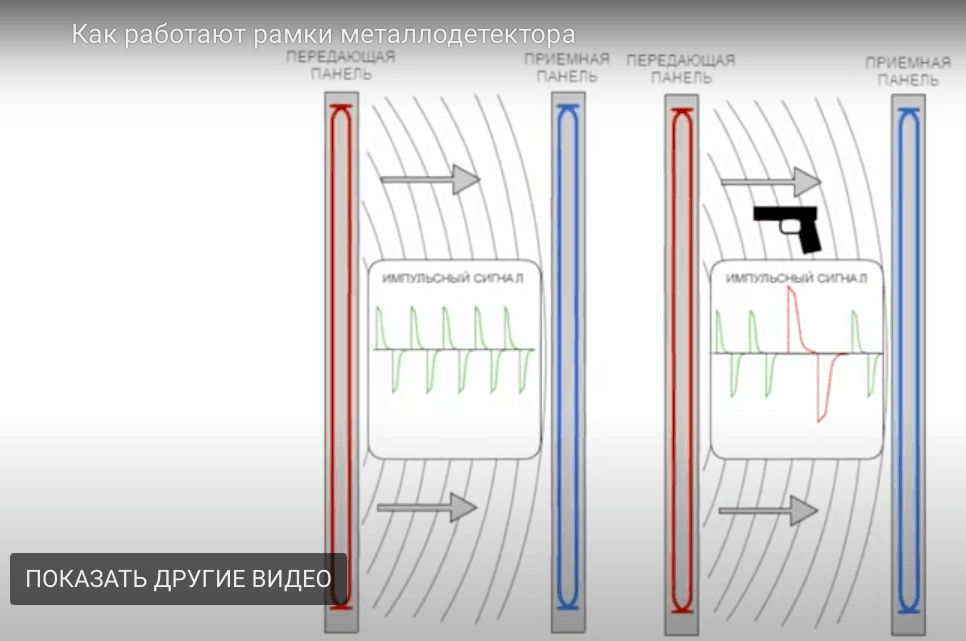Metal detector frames installed in subways, schools, shopping malls and government offices have been blamed for a range of diseases, from DNA damage to cancer and infertility. We decided to check whether there is scientific evidence that metal detectors are harmful.
Possible harm from metal detectors worries many categories of citizens: parents of schoolchildren, pregnant women and only women planning to become pregnant, nursing mothers and those who regularly use public transport. For example, a St. Petersburg resident, whose real name is not disclosed by the media, complained Commissioner for Children's Rights Svetlana Agipova about the harm of this framework. He began his letter with a terrifying wording: “The metropolitan of the Northern capital kills the health of residents and guests of our city every day.” The man further reported that the radiation emanating from the frames affects the cardiovascular, immune and reproductive systems, including causing damage to the nervous system, changing its response, electroencephalogram, blood-brain barrier, causing disruption of circadian rhythms by interfering with the functioning of the pineal gland and creating hormonal imbalances, changes in heart rate and blood pressure, worsening immunity to pathogens, causing weakness, wasting, growth problems, DNA damage and cancer.” Not only St. Petersburg residents are concerned about this issue. In Kazan, the grandmother of a fifth-grader recorded a video message entitled “Your children are being irradiated” (already deleted from the YouTube platform, saved archive pages). In it, she argued that “the frequency (at which the frames operate. - Ed.) awakens cancer cells and triggers oncological processes. This frequency welds the cells of the genitourinary system.”
Another opponents of the framework are those who call themselves “experts in matters of aurography.” “What is the influence of electromagnetic fields on the aura is a very complex question,” claim They. “If a person comes from a village and walks around Moscow for two days, of course, he will be “de-energized”: I have observed this in my practice.” Still concerned parents from different regions write appeals officials, in the Moscow region they went further: in Balashikha, parents distribute leaflets against metal detectors, and in Elektrostal the father banned son to attend school out of bounds.
A metal detector is device, which allows you to detect metal objects in a neutral or weakly conducting environment due to their conductivity. For example, different types of devices allow you to find metal objects in the ground, in water, in the walls of houses, under clothing, in luggage or in food products.
In 1874, French inventor Gustave Trouvé built the first prototype of a metal detector. According to his plan, the device was supposed to make it easier for miners to find metal deposits. An attempt to use a device to locate a metal object in the human body undertook inventor Alexander Bell in 1881. When the 20th President of the United States, James Garfield, was assassinated, a bullet was lodged in his body. The attending physicians were unable to detect and remove it using the then usual method of probing the wound canal, and Bell offered his help. He assembled his device, tested it by shooting first at a tree, then at animal carcasses, and finally successfully tested it on a Civil War veteran who also had a bullet lodged in his body. However, in the case of the president, the device did not work. First, the president's physician insisted that Bell only look for the bullet on the right side, and a post-mortem autopsy showed it was on the left. Secondly, the metal springs of the bed on which the president was lying prevented the correct operation of the device. Thus, the Bell metal detector did not find practical application.
Only in 1925, a German emigrant to the USA Gerhard Fischer patented its version of a metal detector, which was intended to prevent the theft of metal parts from factories. A company founded by an inventor works and today, producing metal detector frames for security, as well as producing devices for industrial purposes and for treasure hunters.
Most modern metal detectors work according to the “reception-transmission” principle, that is, the device contains two inductance coils: receiving and transmitting. If a metal object is placed between them, the length of the reflected pulse will change, and the operator will receive a sound or light signal.
The frame can be single-zone or multi-zone; in the first case, it simply detects the presence of a metal object, in the second, it also indicates its approximate location. The principle of operation of the device is also clearly shown in this video.

The radiation in such devices is most often electromagnetic, it applies to non-ionizing radiation. In addition to metal detectors, the principle of electromagnetic fields (EMF) used in power lines, microwave ovens, computers, televisions and mobile phones.
Back in 1996, WHO began a large multidisciplinary project to study the effects of EMF on the human body. By data WHO, the results of at least 25,000 studies have been published. Experts note that “today, scientific knowledge in this area is much broader than that for most chemicals.” The WHO is clear in its assessment: “Available evidence does not indicate the existence of adverse health effects from exposure to low levels of electromagnetic fields.” Separately, the organization notes that such “blurred” health problems as headaches, anxiety, suicidal thoughts and depression, nausea, fatigue and loss of libido may be associated with EMF, but not directly. It is not electromagnetic fields that cause these symptoms, but the anxiety of the person himself associated with them. The organization also analyzed the effect of EMF on pregnancy: exposure to the fields does not increase the risk of spontaneous miscarriage, congenital malformations, low birth weight or congenital diseases.
Moreover, we should not forget that EMF is not exclusively anthropogenic radiation. It is the electromagnetic fields of our planet that force the compass needle to always point north, and electric fields are also formed in the air during a thunderstorm. IN research Using a separate model of a metal detector, scientists compared the impact of the device with the constant radiation to which we are exposed from the prenatal period until death. One pass through such a detector is equal in amount of radiation to just five minutes of life on Earth. And the American Foundation for Cancer Prevention and Treatment countedthat passing through a metal detector at an airport is equal in amount of radiation to one to three minutes of flying on an airplane. That is, during the flight itself, the passenger will receive a much higher dose of radiation than during scanning with a metal detector. Environmental Protection Agency (USA) leads similar figures: backscatter scanners that use low-energy X-rays are absolutely safe, because the amount of radiation received per scan is equal to two minutes of flight.
If you try to predict the risk of cancer, it turns out that only six out of 100 million air passengers will develop cancer. For comparison, chance to crash on a transatlantic flight from Heathrow (London) to New York's John F. Kennedy Airport is 1 in 5.4 million, that is, more than three times higher!
The scanners you pass through at baggage inspection points are also safe for health. By standards production, radiation from them does not exceed a dose of 0.5 milliroentgen per hour at any point 5 cm from the outer surface. According to estimates by the US Food and Drug Administration, a person receives 360 milliroentgens per year of normal life. The department also notes that it is absolutely safe for pregnant women or children to be near such scanners, as well as to consume food and drinks that have passed through such a scanner.
Russian departments, in particular Rospotrebnadzor and the FSB, checked safety of the Moscow metro framework. They concluded that “X-ray doses correspond to the permissible level established by sanitary and hygienic requirements.”
It is worth noting that people with a pacemaker are extremely not recommended pass through a metal detector. This is because the pacemaker is sensitive to all electromagnetic and magnetic fields, so a metal detector can cause it to malfunction. At the same time, most metal detectors have such a warning on the body; moreover, doctors warn patients who have undergone this intervention about the restrictions.
Thus, metal detectors installed in public buildings, schools, train stations, airports and shopping centers are not known to cause any illness. There is limited data showing a correlation between a single cancer diagnosis and chronic exposure to EMFs in children, but scientists have not yet found a cause-and-effect relationship. Scanners that use low-energy X-rays and are used at the airport can also be called safe, since their radiation is extremely low.
Cover image: Flickr

Not true
Read on the topic:
- Is it true that vaccinated people can be seen using Bluetooth?
- Is it true that microwaved food becomes carcinogenic?
If you find a spelling or grammatical error, please let us know by highlighting the error text and clicking Ctrl+Enter.







